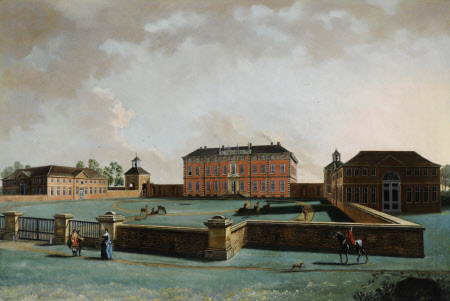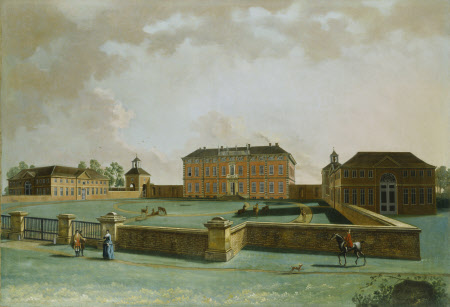The North Front of Beningbrough Hall
John Joseph Bouttats (b. Antwerp 1708 - active in London in the 1740s and Yorkshire around 1751) and John Chapman
Category
Art / Oil paintings
Date
1751 (signed and dated)
Materials
Oil on canvas
Measurements
1219 x 1778 mm (48 x 70 in)
Place of origin
England
Order this imageCollection
Beningbrough Hall, North Yorkshire
NT 1191214
Summary
Oil painting on canvas, The North Front of Beningbrough Hall. Signed, lower right, on rocks: J. Bouttats / J. Chapman pinxit / 1751. A view of the main (north) front of Beningbrough Hall, seen from ground level and at a slight angle. Within the walled enclosure in front of the house is a small group of deer; on a footpath outside the gates are a group of two men and a woman pausing to look at the house, and a man approaching on horseback, with a dog. On either side of the walled enclosure are two two-storey service blocks with pedimented doorways and double-height doors with fanlights on the north side. The sun shines from the south west and casts long shadows, suggesting that it is evening.
Full description
There are two main areas of contention with this work: 1) Who the artists were and 2) whether it is an accurate representation of Beningbrough in 1751. 1) Terry F. Friedman's 1976 article (‘A Temple Newsam Mystery Solved’, Leeds Art Calendar, no.78 [1976], pp.5-11) was based upon investigation of the Beningbrough work when it still remained in private hands and before conservation, with some uncertainty over the signatures and date. He suggested that the signature may have been 'T.Chapman' and identifies this as possibly Thomas Chapman snr, a painter working in York c.1726-1768. Friedman compared the Beningbrough work to a very similar one showing Temple Newsam (now in Leeds Museums collection: LEEAG.PA.1948.0022.0110) and suggested Chapman was the painter of both. More recent investigation of the Temple Newsam work revealed very faint traces of a signature that may be 'Chapman'. However, while Thomas Chapman remains identified as the artist in the Temple Newsam case, close investigation of the Beningbrough work in 2005 confirmed that the initial letter is 'J' and not 'T' (as well as clarifying the 1751 date). As a result, this has now been attributed to a London-based artist called John Chapman who has been associated with at least two other similar topographical works, including one (signed) of Birdcage Walk (dated 175?) and another (unsigned) of Horse Guards Parade (c.1760) (this now in the Government Art Collection GAC13335). The second signature 'J.Bouttats' has been identified as most likely to be that for John Joseph Bouttats, a Flemish-born artist who was based in Hull for a period up to and including 1752 (see David Connell, 'John Anderson and John Bouttats Picture Dealers' in 'Auctions, Agents and Dealers: The Mechanisms of the Art Market 1660-1830', Warren & Turpin (eds) [2007] pp-113-26) N.B. confusingly, John Joseph's younger brother, John Baptist Henry Bouttats (1712-1768), was a London-based art dealer and restorer who called himself John Bouttats. The younger brother carried out painting restoration work for Lord Irwin at Temple Newsam in 1750 and for this reason has also been associated with the undated Temple Newsam painting, although there is no direct evidence for this. Equally, it is also possible that it was this younger brother John who had a hand in the Beningbrough work and it his name above that of John Chapman and not his older brother, Joseph. The Bouttats brothers were sons of Jan or Johann Baptiste Bouttats (1670-1743), a Flemish artist who moved his family to Hull in the early 1720s and then moved to York about 1728. He painted maritime and topographical scenes and works attributed to him include a prospect of Heslington Hall, York dated c.1720s (private collection), 'A Dutch mansion' signed and dated 1730 (Shipley Art Gallery, Gateshead TWCMS: B9987) and three 1738 views of Kirkstall Abbey, Leeds (Leeds Art Gallery). See also an unsigned view of Seaton Deleval in the National Trust collection (see NT 1276849) which has also been attributed to John Joseph. 2) The accuracy of the Beningbrough work has been much discussed, in particular the two side wings which are not present today and for which no firm archaeological evidence has yet been found. Friedman suggests that in regards to these features, the work represents an 'artist's impression' of proposed architectural improvements rather than anything actually built. Others have suggested that the style of windows in the side wings appear relatively old fashioned compared to the main house block and therefore may have been more likely to have existed (perhaps even pre-dating the c.1716 house). Other features in the house appear to be extremely accurate, although there are some differences; notably the four statues on the roof (only plinths exist today) and the number of panes in the sash windows (probably replaced later in the 18thc).
Provenance
Painted in 1751 for John Bourchier jnr (1710-1759) - the year after he was High Sheriff of Yorkshire - and hung at Micklegate House in York (completed for John Bourchier in 1752); it is recorded as having been part of the overmantel in the library (see 'An 18th Century House in York' by George Benson in The Architectural Review Aug. 1897, p114). On John Bourchier’s death in 1759 the house reverted to his widow Mildred, née Roundell, who lived there until her death in 1796, after which it was owned by the Crompton family (connected with Esholt Hall). The painting appears to have stayed in situ through the 19th century until the contents and house were sold in Sept/Oct 1896 prior to being refitted as a chemist's shop. Lewis Payan Dawnay (1846-1910; inherited Beningbrough in 1891) is recorded as purchasing the painting at this sale (Yorkshire Gazette 10.10.1896, p4,col.6). This is confirmed by Dawnay's personal accounts which reveal that in 1896 he paid £16.12s.Od. for an “Old picture of B'bro’ 1731 [sic]”, and even more - £18 – to John Rutley for “Restoring Same”. The painting was inherited with Beningbrough Hall and estate by his eldest son, Guy Payan Dawnay (1878-1952) and can be seen hanging on the ground floor below the main staricase in a 1916 photograph. Guy Dawnay retained the painting when he sold Beningbrough to Lady Chesterfield in 1917; thence by descent, until sold through Gurr Johns Ltd to the National Trust in 2005, when it was bought with the aid of a donation from Mr Ian F Reddihough and a grant of £60,000 from the Art Fund.
Credit line
Beningbrough Hall, The Chesterfield and Dawnay Collection (accepted in lieu of tax from HM Treasury and transferred in 1958)
Marks and inscriptions
Recto: In 1976 Terry F. Friedman recorded a label on the frame which read Beningborough Hall 1731 J. Boutell and J. Chapman
Makers and roles
John Joseph Bouttats (b. Antwerp 1708 - active in London in the 1740s and Yorkshire around 1751) and John Chapman , artist John Chapman (fl.1750 - 1780), artist John Joseph Bouttats (Antwerp 1708 - c.1768) , artist
References
Friedman 1976 Terry F. Friedman, ‘A Temple Newsam Mystery Solved’, Leeds Art Calendar, no.78 [1976], pp.5-11. David Connell, 'John Anderson and John Bouttats Picture Dealers' in 'Auctions, Agents and Dealers: The Mechanisms of the Art Market 1660-1830', Warren & Turpin (eds) [2007] pp-113-26

